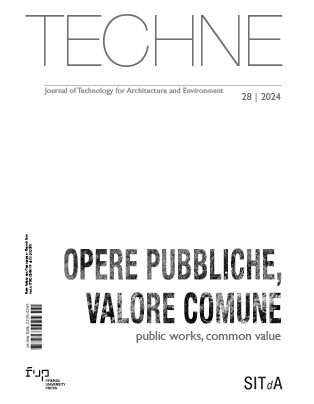Published 2024-10-29
Keywords
- Appropriate technologies,
- Circular processes,
- Inclusion,
- Participation,
- Palestine
How to Cite
Copyright (c) 2024 Alessio Battistella, Timothy Daniel Brownlee, Elisa Ferrato

This work is licensed under a Creative Commons Attribution 4.0 International License.
Abstract
This paper describes the outcome of an international cooperation project aiming at contributing to the protection and the promotion of rights of people with disabilities and to their participation in increasingly inclusive and accessible communities. In Palestine, military occupation causes a lack of basic infrastructures, empty land and planning, de-facto making public areas rare. The opportunity to access an inclusive and safe space is a fundamental factor in quality of living. The participatory processes applied here to implement spatial transformation through sustainable micro-infrastructures foster awareness and knowledge sharing among the participants, despite the obstacles and limits acknowledged herein, opening to possible future developments.
Downloads
References
- Al Mazri N. (2021), “Inclusive education in Occupied Palestinian Territories”, The Disability Under Siege Network. Available at: https://disabilityundersiege.org/wp-content/uploads/2021/03/Literature-Review-Education-OPT-FINAL.pdf (Accessed on 28/02/2024).
- Bignante E. (2010), “The use of photo-elicitation in field research Exploring Maasai representations and use of natural resources”, EchoGéo 11, pp. 1–20, http://dx.doi.org/10.4000/echogeo.11622. DOI: https://doi.org/10.4000/echogeo.11622
- Bignante E. (2011), Geografia e ricerca visuale, Giuseppe Laterza & figli, Roma.
- Creswell J. W. (2007), Qualitative inquiry and research design: Choosing among five approaches, Sage, London.
- El-Atrash A. (2020), “Placemaking interventions in Palestine as demonstrations effects on the ground”, The journal of public space Vol. 5 n I. Available at: https://www.journalpublicspace.org/index.php/jps/article/view/1256/769 (Accessed on 28/02/2024).
- Gehl Institute (2018), “Inclusive Healthy Places. A Guide to Inclusion & Health in Public Space: Learning Globally to Transform Locally”. Available at: http://ihp.gehlpeople.com/wp-content/uploads/2022/08/Inclusive-Healthy-Places_Gehl-Institute.pdf (Accessed on 28/02/2024).
- Giofré F., Dreifuss-Serrano C. (2020), “Micro-rigenerazione di spazi pubblici in aree marginali: processi a confronto”, Techne 19, pp. 162-169. Available at: http://dx.doi.org/10.13128/techne-7819.
- Harper D. (1988), “Visual sociology: Expanding sociological vision”, The American sociologist 19(1), pp. 54-70. Available at: http://dx.doi.org/10.1007/BF02692374. DOI: https://doi.org/10.1007/BF02692374
- Harper D. (2002), “Talking about pictures: A case for photo elicitation”, Visual studies 17(1), pp. 13–26. Available at: http://dx.doi.org/10.1080/14725860220137345. DOI: https://doi.org/10.1080/14725860220137345
- Haselsteiner E. (2023), Robust architecture, low-tech design, Edition Detail, Munich. DOI: https://doi.org/10.11129/9783955536022
- Ministry of Education & Higher Education (2015), Palestine Inclusive Education Policy. Available at: https://www.eenet.org.uk/resources/docs/English – IE Policy.pdf (Accessed on 28/02/2024).
- Patton M. (1990), Qualitative Evaluation and Research Methods, SAGE Publications, Newbury Park.
- Rossman G.B., Rallis S.F. (1998), Learning in the field: an introduction to qualitative research, Sage, London.
- Salamanca O.J. (2022), “In the Excess of Splintering Urbanism: The Racialized Political Economy of Infrastructure”, Journal of Urban Technology 29(5), pp. 1-9. Available at: http://dx.doi.org/10.1080/10630732.2021.2009287. DOI: https://doi.org/10.1080/10630732.2021.2009287
- Sen A. (1992), Inequality Reexamined, Cambridge University Press, Cambridge.
- UN (2022), “The Sustainable Development Goals Report”. Available at: https://unstats.un.org/sdgs/report/2022/The-Sustainable-Development-Goals-Report-2022.pdf (Accessed on 28/02/2024).
- UN-Habitat (2018), “Palestine Habitat Country Programme Document (2018-2022)”. Available at: https://unhabitat.org/sites/default/files/documents/2019-05/habitat_country_programme_document_-_palestine_2018-2022.pdf (Accessed on 28/02/2024).
- UN-Habitat (2020), “Placemaking toolkit: Designing people places. A toolkit for communities and designers to design and implement public spaces and buildings in Palestine”. Available at: https://unhabitat.org/sites/default/files/2020/04/placemaking_toolkit_eng_27042020.pdf (Accessed on 28/02/2024).
- UNRWA (2017), “Disability inclusion guidelines”. Available at: https://www.unrwa.org/sites/default/files/content/resources/disability_inclusion_guidelines.pdf (Accessed on 28/02/2024).
- Weizman E. (2007), Hollow land. Israel’s architecture of occupation, Verso, New York.
- World Bank (2016), West Bank and Gaza. Disability in the Palestinian Territories: Assessing situation and services for people with disabilities, Ramallah: World Bank.






